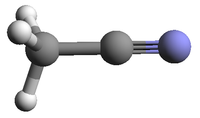|
While the first entry from Dec. 2009 was restricted to
ground state data only, the present entry is based on
data pertaining to the vibrational states v8
≤ 2 and takes into account interactions between
these states. Interactions with states v4
= 1, v7 = 1, and v8 = 3
were accounted for through spectroscopic parameters and
appropriate interaction parameters. The fit was described
in
(1) H. S. P. Müller, L. R. Brown, B. J. Drouin, J. C.
Pearson, I. Kleiner, R. L. Sams, K. Sung, M. H. Ordu,
and F. Lewen,
2015, J. Mol. Spectrosc. 312, 22.
Vibrational ground state data with 14N hyperfine
splitting were taken from
(2) S. G. Kukolich, D. J. Ruben, J. H. S. Wang, and J. R. Williams,
1973, J. Chem. Phys. 58, 3155;
from
(3) S. G. Kukolich,
1982, J. Chem. Phys. 76, 97;
and from
(4) D. Boucher, J. Burie, J. Demaison, A. Dubrulle, J.
Legrand, and B. Segard,
1977, J. Mol. Spectrosc. 64, 290.
Additional, extensive data between 91 ans 790 GHz were
taken from
(5) G. Cazzoli and C. Puzzarini,
2006, J. Mol. Spectrosc. 240, 153.
Two K = 14 transitions were taken
from
(6) M. Šimecková, Š. Urban, U. Fuchs,
F. Lewen, G. Winnewisser, I. Morino, K.M.T. Yamada,
2004, J. Mol. Spectrosc. 226, 123.
Further extensive data up to 1.63 THz were reported
in (1) and in
(7) H. S. P. Müller, B. J. Drouin, and J. C. Pearson,
2009, Astron. Astrophys. 506, 1487.
The purely K-dependent terms were determined through
ΔK = 3 infrared loops
from
(8) R. Anttila, V.-M. Horneman, M. Koivusaari, and
R. Paso,
1993, J. Mol. Spectrosc. 157, 198,
and from the interactions treated in (1).
The v8 = 1 data were mostly taken
from (1). Additional millimeter wave data come
from
(9) A. Bauer and S. Maes,
1969, J. Phys. (Paris) 30, 169.
The ν8 data were published
by
(10) M. Koivusaari, V.-M. Horneman, and R. Anttila,
1992, J. Mol. Spectrosc. 152, 377.
The v8 = 2 data as well as the
2ν8 data were mostly taken from (1).
Additional data come from
(11) A. Bauer and S. Maes,
1969, C. R. Acad. Sci. Ser. B 268, 1569,
and from
(12) R. Bocquet, G. Wlodarczak, A. Bauer, and J. Demaison,
1988, J. Mol. Spectrosc. 127, 382.
Parameters of three higher vibrational states were
taken from
(13) A.-M. Tolonen, M. Koivusaari, J. Schroderus,
S. Alanko, and R. Anttila,
1993, J. Mol. Spectrosc. 160, 554.
Vibrational identifiers in this and related entries are
0 for v = 0 (1 with HFS),
2 for v8 = 1, l = –1 (4 with HFS),
3 for v8 = 1, l = +1 (5 with HFS),
6 for v8 = 2, l = 0 (9 with HFS),
7 for v8 = 2, l = +2 (10 with HFS),
8 for v8 = 2, l = –2 (11 with HFS).
Transitions between vibrational states occur in the lower
energy entry.
The predictions should be reliable throughout.
14N hyperfine splitting may be resolvable
at low values of J and possibly at the highest
K. Therefore, predictions with
hyperfine splitting have been provided up to
J' = 15 (280 GHz) along with
partition function values. The rotational part of the
partition function is complete up to 500 K
(J up to 140 and K up to 30).
Vibrational contributions have been considered in
the calculation of the partition function for states
up to about 1200 cm–1.
Higher vibrational states contribute to less than
3.0 % at 300 K.
Additional information on
vibrational states is also available.
At low temperatures, it may be necessary to discern between
A-CH3CN and E-CH3CN.
The A state levels are described by
K = 3n, those of E state
by K = 3n ± 1.
The nuclear spin-weight ratio is 2 : 1 for
A-CH3CN with K > 0
and all other states, respectively.
The JK = 11
level is the lowest E state level.
It is 5.5803 cm–1 above ground.
Nov. 2010: separate
E and
A predictions are available along with separate
E and
A partition function values.
NOTE: Before any analyses
are performed treating E and A states separately
the effects of optical depth ought to be evaluated
carefully ! These data are from the previous entry.
The ground state dipole moment was determined by
(14) J. Gadhi, A. Lahrouni, J. Legrand, and J. Demaison,
1995, J. Chim. Phys. 92, 1984.
|
